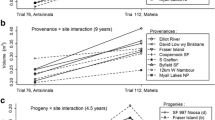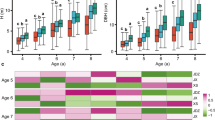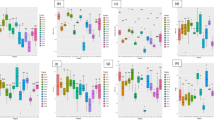Abstract
Investment in silvicultural techniques is noticeably lacking, especially in breeding programs for non-conventional wood species. Studying genotype × environment interaction (G × E) is essential to the development of breeding programs. Thus, this study aimed to estimate genetic diversity of and the effects of G × E interaction on two progeny tests of Cordia trichotoma, including the estimation of genetic gain and genetic diversity after selection. For the experiment, 30 progenies of C. trichotoma were tested at two sites with differing soil textures. Diameter at breast height (1.30 m above soil surface, dbh-cm), total height, diameter at 30 cm from the soil, first branch height, and survival were all monitored for four years. Statistical deviance, best linear unbiased estimator, and harmonic mean of relative performance of genetic values (MHPRVG) were all calculated to predict breeding values, estimate genetic parameters, and analyze deviance. All quantified traits varied significantly among progenies by soil type, with greatest variation recorded for genetic variability. Heritability of the progenies led to predictions of genetic gain, ranging from 7.73 to 15.45%, for dbh at four years of age. The calculated decrease in genetic diversity after selection showed that this parameter should be monitored in subsequent breeding cycles. G × E was low for all tests. The best-performing progenies proved most stable and best adapted to the different environmental conditions tested.



Similar content being viewed by others
References
Aguiar AVD, Vencovsky R, Chaves LJ, Moura MF, Morais LKD (2009) Genetics and expected selection gain for growth traits in Eugenia dysenterica DC. populations. Bragantia 68(3):629–637
Berlin M, Jansson G, Karl-Anders H (2015) Genotype by environment interaction in the southern Swedish breeding population of Picea abies using new climatic indices. Scand J For Res 30(2):112–121
Brack P, Grings M (2011) Espécies nativas da flora brasileira de valor econômico atual ou potencial: plantas para o futuro - Região Sul. MMA, Brasília, p 936
Burdon RD, Li Y (2019) Genotype-environment interaction involving site differences in expression of genetic variation along with genotypic rank changes: simulations of economic significance. Tree Genet Genomes 15(1):2
Callister AN (2013) Genetic parameters and correlations between stem size, forking, and flowering in teak (Tectona grandis). Can J For Res 43(12):1145–1150
Carbonell SAM, Chiorato AF, Resende MDV, Dias LAS, Beraldo ALA, Perina EF (2007) Estabilidade em cultivares e linhagens de feijoeiro e diferentes ambientes no estado de São Paulo. Bragantia 66(2):193–201
Carvalho LPD, Farias FJC, Morello CDL, Teodoro PE (2016) Selection of cotton genotypes for greater length of fibers. Crop Breeding and Applied Biotechnology 16(4):340–347
Chinelato FCS, de Moraes CB, Carignato A, Tambarussi EV, Zimback L, Palomino EC, Mori ES (2014) Genetic variability in guapuruvu Schizolobium parahyba progenies. Scientia Agropecuaria 5(2):71–76
Cobb JN, Juma RU, Biswas PS, Arbelaez JD, Rutkoski J, Atlin G, Ng EH (2019) Enhancing the rate of genetic gain in public-sector plant breeding programs: lessons from the breeder’s equation. Theor Appl Genet 132(3):627–645
Cornelius J (1994) Heritabilities and additive genetic coefficients of variation in forest trees. Can J For Res 24(2):372–379
Cruz CD (2013) Genes: a software package for analysis in experimental statistics and quantitative genetics. Acta Sci Agron 35(3):271–276
da Costa RB, Martinez DT, Chichorro JF, Bauer MDO, Cezana DP, de Souza TR (2015) Progeny performance at pre-breeding stage of Tectona grandis Lf in Espírito Santo State. Scientia Forestalis 43(105):211–216
de Leon N, Jannink JL, Edwards JW, Kaeppler SM (2016) Introduction to a special issue on genotype by environment interaction. Crop Sci 56(5):2081–2089
de Resende MD, Ramalho MA, Guilherme SR, de FB Abreu Â, (2015) Multigeneration index in the within-progenies bulk method for breeding of self-pollinated plants. Crop Sci 55(3):1202–1211
do Nascimento Senna S, Freitas MLM, Zanatto ACS, Morais E, Zanata M, De Moraes MLT, Sebbenn AM, (2012) Variação e parâmetros genéticos em teste de progênies de polinização livre de Peltophorum dubium (Sprengel) taubert em Luiz Antonio -SP. Scientia Forestalis 40(95):345–352
Du Q, Yang X, Xie J, Quan M, Xiao L, Lu W, Tian J, Gong C, Cen J, Li B, Zhang D (2019) Time-specific and pleiotropic quantitative trait loci coordinately modulate stem growth in Populus. Plant Biotechnol J 17(3):608–624
Freitas MLM, Sebbenn AM, Morais E, Zanatto ACS, Verardi CK, Pinheiro NA (2006) Parâmetros genéticos em progênies de polinização aberta de Cordia trichotoma (Vell.) ex Steud. Revista Instituto Florestal 18:95–102
Gapare WJ, Ivković M, Liepe KJ, Hamann A, Low CB (2015) Drivers of genotype by environment interaction in radiata pine as indicated by multivariate regression trees. For Ecol Manage 353:21–29
Gezan SA, de Carvalho MP, Sherrill J (2017) Statistical methods to explore genotype-by-environment interaction for loblolly pine clonal trials. Tree Genet Genomes 13(1):1
Goh DK, Bacilieri R, Chaix G, Monteuuis O (2013) Growth variations and heritabilities of teak CSO-derived families and provenances planted in two humid tropical sites. Tree Genet Genomes 9(5):1329–1341
Gonçalves PS, Bortoletto N, Martins ALM, Costa RB, Gallo PB (2003) Genotype-environment interaction and phenotypic stability for girth growth and rubber yield of Hevea clones in São Paulo State. Brazil Genetics and Molecular Biology 26(4):441–448
Gonçalves GM, Viana AP, Amaral Junior ATD, Resende MDVD (2014) Breeding new sugarcane clones by mixed models under genotype by environmental interaction. Scientia Agricola 71(1):66–71
Govindaraj M, Vetriventhan M, Srinivasan M (2015) Importance of genetic diversity assessment in crop plants and its recent advances: An overview of its analytical perspectives. Genetics Research International 2015:1–14
Heslot N, Akdemir D, Sorrells ME, Jannink JL (2014) Integrating environmental covariates and crop modeling into the genomic selection framework to predict genotype by environment interactions. Theor Appl Genet 127(2):463–480
Hill WG, Mulder HA (2010) Genetic analysis of environmental variation. Genetics Research 92(5–6):381–395
Ibá, Indústria Brasileira de Árvores. Anuário estatístico, 2015 ano base 2014.
Kang MS (2002) 15 Genotype–Environment Interaction: Progress and Prospects. Quantitative genetics, genomics, and plant breeding 219.
Koo YB, Yeo JK, Woo KS, Kim TS (2007) Selection of superior clones by stability analysis of growth performance in Populus davidiana Dode at age 12. Silvae Genetica 56(1–6):93–101
Leonardecz-Neto E, Vencovsky R, Sebbenn AM (2003) Ajuste para a competição entre plantas em teste de progênies e procedências de essências florestais. Scientia Forestalis 63:136–149
Li Y, Suontama M, Burdon RD, Dungey HS (2017) Genotype by environment interactions in forest tree breeding: review of methodology and perspectives on research and application. Tree Genet Genomes 13(3):60
Maia MCC, Resende MDV, Paiva JR, Cavalcanti JJV, Barros LM (2009) Seleção simultânea para produção, adaptabilidade e estabilidade genotípicas em clones de cajueiro, via modelos mistos. Pesquisa Agropecuária Tropical 39(1):43–50
Manfio CE, Motoike SY, Resende MDV, Santos CEM, Sato AY (2012) Avaliação de progênies de macaúba na fase juvenil e estimativas de parâmetros genéticos e diversidade genética. Pesquisa Florestal Brasileira 32(69):63–68
McDonald TM, Apiolaza LA (2009) Genotype by environment interaction of Pinus radiata in New Zealand. In: the Second Australasian Forest Genetics Conference, Perth, Australia, 20–22 Abril.
Meyer K (2009) Factor-analytic models for genotype x environment type problems and structured covariance matrices. Genet Sel Evol 41:21
Mohammadi R, Farshadfar E, Amri A (2015) Interpreting genotype× environment interactions for grain yield of rainfed durum wheat in Iran. The Crop Journal 3(6):526–535
Moiana LD, Vidigal Filho PS, Gonçalves-Vidigal MC, Maleia MPE, Mindo N (2014) Application of mixed models for the assessment genotype and environment interactions in cotton (Gossypium hirsutum) cultivars in Mozambique. Afr J Biotech 13:1985–1991
Moreira GR, da Silva DJH, Carneiro P, Picanço MC, Vasconcelos ADA, Pinto CMF (2013) Herança de caracteres de resistência por antixenose de Solanum pennellii à traça-do-tomateiro em cruzamento com “Santa Clara.” Hortic Bras 31(4):574–581
Mugasha WA, Bollandsås OM, Eid T (2013) Relationships between diameter and height of trees in natural tropical forest in Tanzania. Southern Forests: a Journal of Forest Science 75(4):221–237
Namkoong G, Kang HC, Brouard JS (2012) Tree breeding: principles and strategies: principles and strategies (Vol. 11). Springer Science & Business Media, p 56–73
Negreiros JRS, Bergo CL, Migueloni DP, Pereira AM (2013) Divergência genética entre progênies de pupunheira quanto a caracteres de palmito. Pesq Agrop Brasileira 48(5):496–503
Pagliarini MK, Kieras WS, Moreira JP, Sousa VA, Shimizu JY, Moraes MLT, Aguiar AV (2016) Adaptability, stability, productivity and genetic parameters in slash pine second-generation families in early age. Silvae Genetica 65(1):71–82
Pupin S, de Freitas MLM, Canuto DDO, da Silva AM, Marin ALA, de Moraes MLT (2017) Genetic variability and genetic gains in progenies of Myracrodruon urundeuva Fr. All. in multi-species system. Nativa: Pesquisas Agrárias e Ambientais 5(1):59–65
R Development Core Team (2013) R: a language and environment for statistical computing. R Foundation for Statistical Computing, Vienna
Regitano Neto A, Ramos Júnior EA, Gallo PB, Freitas JG, Azzini LE (2013) Comportamento de genótipos de arroz de terras altas no estado de São Paulo. Revista Ciência Agronômica 44:512–519
Resende MDV (2002) Genética biométrica e estatística no melhoramento de plantas perenes. EMBRAPA Informação Tecnológica, Brasília, p 975
Resende MDV (2005) Melhoramento de essências florestais. BOREM. A. Melhoramento de espécies cultivadas. Viçosa, Editora UFV, pp 717–780
Resende MDV (2016) Software Selegen-REML/BLUP: a useful tool for plant breeding. Crop Breeding and Applied Biotechnology 16(4):330–339
Resende MDV, Duarte JB (2007) Precisão e controle de qualidade em experimentos de avaliação de cultivares. Pesquisa Agropecuária Tropical 37:182–194
Rocha RB, Vieira AH, Gama MD, Rossi LMB (2009) Genetic evaluation of bandarra (Schizolobium amazonicum) provenances by the REML/BLUP methodology. Scientia Forestalis 37(84):351–358
Rolim SG, Piña-rodrigues FC, Piotto D, Batista A, Freitas MLM, Junior SB, Zakia MJB, Calmon M (2019) Research Gaps and Priorities in Silviculture of Native Species In Brazil. Working Paper. São Paulo, Brazil: WRI Brasil. Available online at https://wribrasil.org.br/pt/publicacoes
Roychowdhury R, Tah J (2011) Evaluation of genetic parameters for agro-metrical traits in carnation genotypes. Afr Crop Sci J 19(3):183–188
Sae-Lim P, Gjerde B, Nielsen HM, Mulder H, Kause A (2016) A review of genotype-by-environment interaction and micro-environmental sensitivity in aquaculture species. Rev Aquac 8(4):369–393
Santos CHA, Santana GX, Sá Leitão CS, Paula-Silva MN, Almeida-Val VMF (2016) Loss of genetic diversity in farmed populations of Colossoma macropomum estimated by microsatellites. Anim Genet 47(3):373–376
Spinelli VM, Dias LAS, Rocha RB, Resende MDV (2015) Estimates of genetic parameters with selection within and between half-sib families of Jatropha curcas L. Ind Crops Prod 69:355–361
Storck L, Lúcio ADC, Krause W, Araújo DVD, Silva CA (2014) Scaling the number of plants per plot and number of plots per genotype of yellow passion fruit plants. Acta Sci Agron 36(1):73–78
Sumardi S, Kurniawan H, Prastyono P (2016) Genetic parameter estimates for growth traits in an Eucalyptus urophylla s.t. blake progeny test in timor island. Indonesian J Forest Res 3(2):119–127
Tambarussi EV, Pereira FB, da Silva PHM, Lee D, Bush D (2018) Are tree breeders properly predicting genetic gain? A case study involving Corymbia species. Euphytica 214(8):150
Temesgen T, Keneni G, Sefera T, Jarso M (2015) Yield stability and relationships among stability parameters in faba bean (Vicia faba L.) genotypes. The Crop Journal 3(3):258–268.
Torres Filho J, Oliveira CNGDS, Silveira L, Nunes GHDS, Silva AJRD, Silva MFND (2017) Genotype by environment interaction in green cowpea analyzed via mixed models. Revista Caatinga 30(3):687–697
Valenzuela CE, Ballesta P, Maldonado C, Baettig R, Arriagada O, Sousa Mafra G, Mora F (2019) Bayesian mapping reveals large-effect pleiotropic QTLs for wood density and slenderness index in 17-year-old trees of Eucalyptus cladocalyx. Forests 10(3):241
Wang J, Santiago E, Caballero A (2016) Prediction and estimation of effective population size. Heredity 117(4):193–206
Wei RP, Lindgren D (1996) Effective family number following selection with restrictions. Biometrics Arlington 52:198–208
Wricke G, Weber E (2010) Quantitative genetics and selection in plant breeding. Walter de Gruyter, p 195–225.
Zakir M (2018) Review on genotype × environment interaction in plant breeding and agronomic stability of crops. J Biol, Agri Healthcare 8:14–21
Zhao XY, BianXY LZX, Wang XW, Yang CJ, Liu GF, Yang CP (2014) Genetic stability analysis of introduced Betula pendula, Betula kirghisorum, and Betula pubescens families in saline-alkali soil of northeastern China. Scand J For Res 29(7):639–649
Acknowledgements
The authors thank the Coordenação de Aperfeiçoamento de Pessoal de Nível Superior (CAPES), Vale S.A., Embrapa Foresta Research Company, and the research technicians of the Project Biomas from Embrapa Forestas and FEIS-UNESP (Universidade Estadual Paulista “Júlio de Mesquita Filho” em Ilha Solteira).
Author information
Authors and Affiliations
Corresponding author
Additional information
Publisher's Note
Springer Nature remains neutral with regard to jurisdictional claims in published maps and institutional affiliations.
Project funding: This work was funded by Coordenação de Aperfeiçoamento de Pessoal de Nível Superior (CAPES).
The online version is available at http://www.springerlink.com.
Rights and permissions
About this article
Cite this article
dos Santos, W., de Souza, B.M., Zulian, D.F. et al. Genotype-environment interaction in Cordia trichotoma (Vell.) Arráb. Ex Steud. progenies in two different soil conditions. J. For. Res. 33, 309–319 (2022). https://doi.org/10.1007/s11676-021-01337-5
Received:
Accepted:
Published:
Issue Date:
DOI: https://doi.org/10.1007/s11676-021-01337-5




